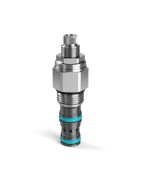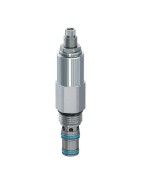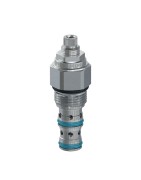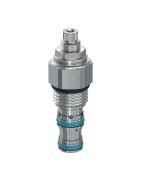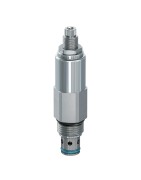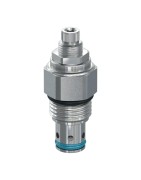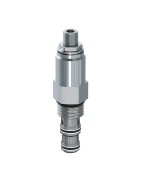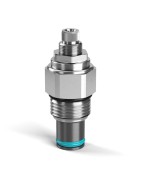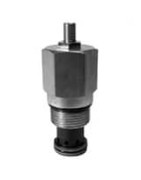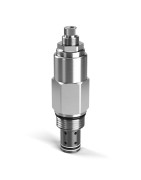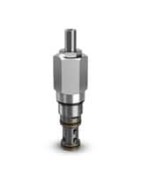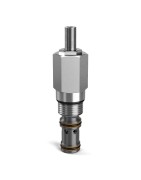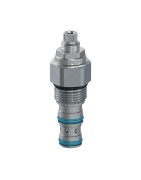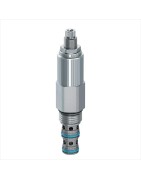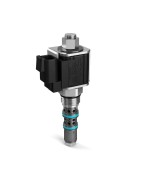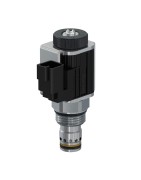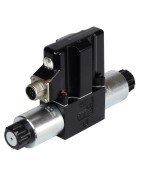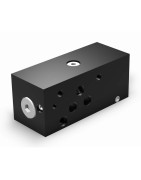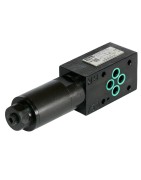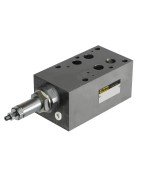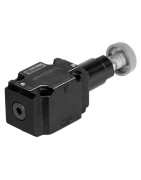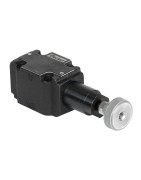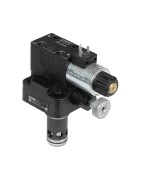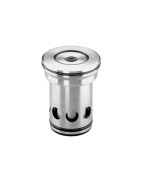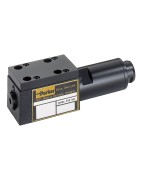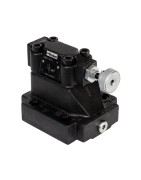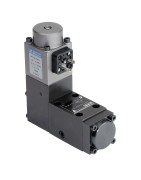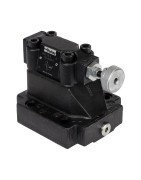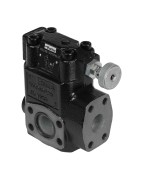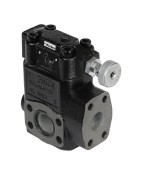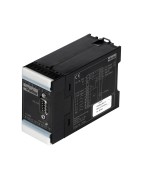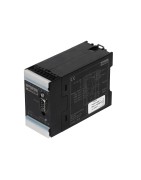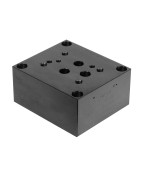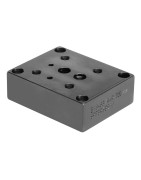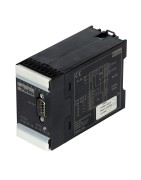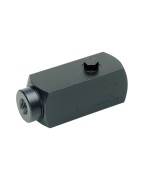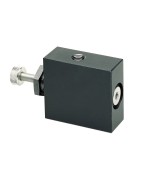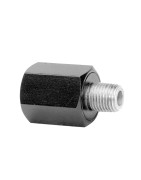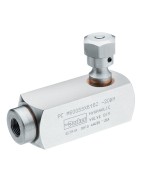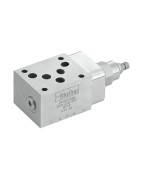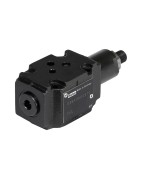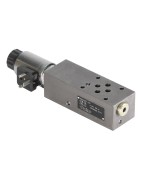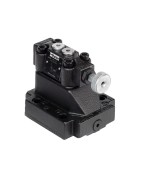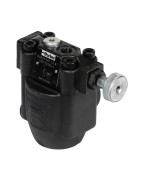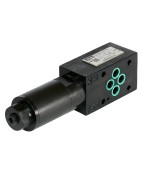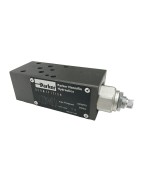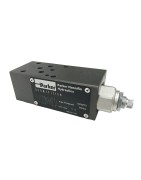Zawory regulacji ciśnienia
Zawory regulacji ciśnienia firmy Parker świetnie uzupełniają nasz obszerny asortyment zaworów regulacji przepływu, zaworów iglicowych i zaworów jednokierunkowych przeznaczonych do montażu przewodowego. Zaliczają się do ciśnieniowych zaworów
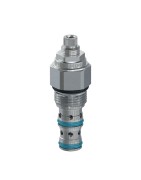
-
Pilot Operated Pressure Reducing Valves
Pilot operated pressure reducing valves are designed for continuous duty applications. Due to their stability and low pressure rise, the pilot operated pressure reducing valves are the best option for setting the pressure of a hydraulic system sub-circuit.
• Spool design provides low hysteresis
• Low parasitic loss
• High pressure capable
• Multiple pressure ranges available for more accurate pressure control
• Adjustable and tamperproof versions available
• All external parts zinc plated
• Hardened, precision ground parts for durability
• “D”-Ring seal standard on Winner's Circle
• Low profile adapter for minimal space requirements
Common circuit applications include: brake release, dual pressure circuits, pilot pressure control and downstream pressure control. -
Direct Acting Pressure Reducing Relieving Valves
Direct Acting Reducing/Relieving valves are applied in a circuit in order to reduce system pressure to the setting of valve to limit the pressure available to a specific branch of a hydraulic circuit. The direct acting function of the normally open valve allows the spool to operate directly against a control spring that is set using the valves internal adjustment setting. As hydraulic pressure is applied to the valve inlet, the spool will shift closed against the spring to limit the pressure that is available to the regulated port to the control setting. The valve will also function as a relief valve to the regulated port in the event of a rise in downstream pressure, protecting the regulated branch of the circuit from pressure spikes. Direct acting reducing/relieving valves are intended or intermittent duty applications with lower duty cycles that will not stress the mechanical operation of the valve. For best performance in the direct acting reducing/relieving valve, the inlet pressure setting should not exceed 1000 PSI (69 Bar) above the reducing valve setting, as high pressure differential could result in instability in the direct acting product. For continuous duty applications or applications where a high differential is required, the pilot operated version of this product should be considered as an alternative solution.
Typical applications are in mobile & industrial equipment, where a branch of the system is intended to operate at a lower setting than high system pressure. Hydraulic functions such as brake circuits, clamping or clutch circuits, suspension systems, street sweepers, or seeding and planting rows in agricultural equipment are common applications for these products.
• Hardened, precision ground parts for durability
• All External parts zinc plated
• Adjustable and tamperproof versions available
• Multiple pressure ranges available for more accurate pressure control -
Zawory redukcyjne i odciążające sterowane pośrednio
Rodzina sterowanych pośrednio zaworów redukcyjnych i odciążających firmy Parker zapewnia doskonałą regulację ciśnienia w zastosowaniach, w których potrzebne jest konkretne ciśnienie regulowane lub otwarcia w celu zapewnienia precyzyjnego działania funkcji wymagających regulowanego ciśnienia do 380 barów (5500 psi) i natężenia przepływu do 150 l/min (40 gal/min). Sterowane pośrednio zawory redukcyjno-odciążające firmy Parker zaprojektowano do kilku zakresów ciśnień, aby zapewnić wyższy stopień kontroli dzięki różnym dostępnym sposobom regulacji. Dodatkowa stabilność uzyskana dzięki sterowaniu pośredniemu sprawia, że zawory te doskonale się nadają do obsługi wrażliwych funkcji, takich jak podnoszenie lub docisk, zaciskanie lub hamowanie w różnych typach maszyn na rynkach mobilnym i przemysłowym.
Rynki:
• Rolnictwo
• Sprzęt budowlany
• Przemysł
• Produkcja
• Urządzenia mobilne
Cechy/zalety:
• Dostępność wielu zakresów ciśnień pozwala na dokładniejszą regulację ciśnienia.
• Kompaktowe rozmiary ograniczają wymagania przestrzenne
• Dostępne wersje regulowane i odporne na ingerencję.
• Możliwość pracy pod wysokim ciśnieniem.
• Wszystkie części zewnętrzne ocynkowane.
Zastosowania:
• Hamulce
• Opaski zaciskowe
• Układy zawieszenia
• Układy podnoszenia/docisku
Dodatkowe informacje techniczne:
Typowe zastosowania to urządzenia mobilne i przemysłowe, w których gałąź układu ma działać przy ustawieniu niższym niż wysokie ciśnienie układu. Funkcje hydrauliczne, takie jak obwody hamulcowe, obwody zaciskowe lub sprzęgła, układy zawieszenia, zamiatarki uliczne, lub rzędy siewu i sadzenia w sprzęcie rolniczym są typowymi zastosowaniami tych produktów. -
Pilot Operated Ventable Relief Valves
Ventable relief valves are pilot operated, spool type pressure controls. Like other pilot operated relief valves, the ventable relief has a main pilot spring chamber, and a bias spring chamber separated by a pilot orifice. The internal adjustment controls the main pilot spring setting. When pressure in the system builds above the setting of the main pilot setting, the pilot seat will lift allowing the spool to travel to the open position passing flow. What makes ventable relief valves unique is the valve offers an isolated vent chamber that is connected to the bias spring chamber. This allows for the valve to open at a lower pressure than the setting of the main spring.
The circuit designer has the ability to apply an external control valve or valves to set the operating pressure of the bias spring that must be overcome to allow the valve to open. This is an ideal solution in applications that may require variable pressure settings in normal operation.
One must consider the leakage component when applying any pilot operated spool type relief valve, as by design, the spool will pass a small leakage flow.
Typical applications are in mobile & industrial equipment, where multiple pressure settings may be required. Applications such as press or lift circuits where multiple pressure settings may be required.
• High flow capacity
• Full tank line back pressure capability
• Excellent flow pressure characteristics for consistent pressure setting
• Ideal for pump relief and remote control or unloading via vent (port 3)
• Integral 250 micron pilot flow filter
• Hardened working parts for maximum durability
• Adjustable and tamperproof versions available
• All external parts zinc plated
• Low override curve
• Ball-type pilot for added stability
• High accuracy - pilot operated design
• Hardened, precision ground parts for durability
• Compact size for reduced space requirements
• All external parts have yellow zinc dichromate. This coating is ideal for salt spray applications. -
Direct Acting Differential Area Relief Valves
Parker Hannifin's RD and RDH line of differential area relief valves provide excellent pressure control in applications where a fast acting, low leakage relief valve is necessary. Parker's family of differential relief valves are available in three sizes (size -08, -10, and -16) with flow capability of up to 40 gpm. The size -16 family is limited to 3500 psi while the rest of the family is capable of 5500 psi. Unlike the direct acting family of relief valves, Parker's differential area relief valves are designed to have the pressure controlled at port 2 of the cavity. This ensures low leakage across the valve, essential in some holding applications. Designed using industry common cavities, the RD and RDH line of reliefs can easily be used in various system applications with ease.
Industries where commonly found:
• Turf
• Agriculture
• Aerial
• Construction
• Mining
• Industrial
• Truck -
Zawory nadmiarowe sterowane pośrednio
Zawory nadmiarowe sterowane pośrednio firmy Parker cechują się stabilną konstrukcją o małym spadku ciśnienia. Przeznaczone są do zastosowań ciągłych przy pracy o niższym poziomie hałasu hydraulicznego. Zawory mają niezawodną i kompaktową konstrukcję i mogą pracować przy ciśnieniu do 420 barów (6000 psi) i natężeniu przepływu do 400 l/min (106 gal/min). Zawory nadmiarowe sterowane pośrednio firmy Parker idealnie nadają się do ograniczania ciśnienia w układzie lub w standardowych zastosowaniach zaworów nadmiarowych w urządzeniach mobilnych i przemysłowych, takich jak urządzenia rolnicze, lotnicze, do przetwarzania odpadów, przemysłowe systemy bloków energetycznych, urządzenia górnicze i inne obwody regulacji ciśnienia płynów przeznaczone do pracy ciężkiej.
Rynki:
• Przemysł
• Produkcja
• Urządzenia mobilne
Cechy/zalety:
• Wysokie ciśnienie i natężenie przepływu.
• Konstrukcje kulowe i grzybkowe o niskim wycieku.
• Kompaktowa konstrukcja.
• Wewnętrzne filtry.
• Hartowane, precyzyjnie szlifowane części zapewnia trwałość
• Wszystkie części zewnętrzne ocynkowane.
Zastosowania:
• Ogranicznik ciśnienia w układzie
• Przyłącze/upust między przyłączami
• Wychylany upust
• Hamowanie silnikiem
Dodatkowe informacje techniczne:
Ta rodzina zaworów najlepiej nadaje się do układów o pracy ciągłej, w których wymagana jest praca zaworu poza okresami użytkowania przerywanego. Mogą być używane do utrzymywania ciśnienia w układzie przez długi czas. Dodatkowo w systemach, w których mogą występować duże szybkości zmian przepływu, zawory sterowane pośrednio mogą dostosować się do tych zmian bez nadmiernego wzrostu ciśnienia. Ze względu na obszary otwarcia przepływu przez zawór zawory suwakowe będą działać ciszej niż konwencjonalne zawory bezpośredniego działania. Należy również wziąć pod uwagę poziom wycieków, ponieważ suwak ze względu na swoją konstrukcję przepuszcza niewielki wyciek, natomiast zawór bezpośredniego działania nie przepuszcza znaczącego przepływu do momentu osiągnięcia ciśnienia otwarcia. Suwakowych zaworów nadmiarowych nie należy używać do utrzymywania obciążenia. -
Unloading Relief Valves
Parker’s RU101 and M04A4J offer design flexibility by allowing the use of hydraulic components to automatically control pump flow to one or more accumulators. These are low flow pilot valves that can be used to control higher pump flows in fixed displacement or load sense systems.
The RU101 is externally piloted and rated for flows up to 1 GPM and pressures up to 3000 psi. It is typically used with fixed displacement pumps and can directly unload flows up to 1 GPM or be used to pilot a logic element to unload higher pump flows. Once the accumulators are charged to the adjustable or factory preset maximum pressure, the pump will automatically unload back to tank. Due to the differential area design, when the pressure drops to 80% of the RU101 maximum setting, the unloading valve will direct pump flow to the accumulators for recharging.
The M04A4J is internally piloted and is rated for flows up to .53 GPM and pressures as high as 6000 psi. It is typically used with load sense pumps to control accumulator charging. When the accumulators are charged to the unload pressure, the pump’s load sense port is directed to tank allowing the pump to go to its standby pressure. Once the accumulator pressure falls to the M04A4J reload pressure, the pump’s load sense port is fed the accumulator pressure and the pump comes on stroke to charge the accumulator back up to the unload pressure. Controlling only the pump load sense signal allows a small cartridge valve to control a wide range of flows from small to larger displacement load sense pumps.
Parker’s unloading pressure control valves offer design flexibility by allowing in-line mounting with standard line bodies, or integration into more complex custom manifolds. They can also be combined with K04G3 shuttles for use in critical applications that require redundant accumulators such as braking and steering. By hydraulically controlling pump unloading for accumulator charging, there may be no need for solenoid valves, pressure sensors, electronic controls, and the associated wiring. Combining the features of the RU101 or M04A4J with the many other products offered by Parker’s Hydraulic Cartridge Division allows for application specific solutions for some of the most demanding applications, including: Construction, Mining, Industrial Power Units, Oil and Gas, Marine, Material Handling. -
Zawory nadmiarowe bezpośredniego działania
Zawory nadmiarowe bezpośredniego działania firmy Parker działają szybko i przeznaczone są do zastosowań ciągłych przy ciśnieniu do 420 barów (6000 psi) i natężeniu przepływu do 200 l/min (53 gal/min) w różnych rozmiarach gniazda. Dzięki różnorodnym dostępnym rodzajom regulacji ciśnienia stanowią ekonomiczne rozwiązanie do obcinania skoków ciśnienia i w razie potrzeby mogą obsługiwać natężenie przepływu całego układu. Zawory grzybkowe bezpośredniego działania mają gniazda o niskim poziomie wycieków i doskonale odciążają przyłącza w zastosowaniach związanych ze sterowaniem siłownikami. Małe zawory bezpośredniego działania firmy Parker o niskim natężeniu przepływu sprawdzają się dobrze podczas sterowania obwodami pilotowymi lub ograniczania ciśnienia wykrywania obciążenia.
Rynki:
• Przemysł
• Produkcja
• Urządzenia mobilne
Cechy/zalety:
• Hartowane, precyzyjnie szlifowane części zapewnia trwałość
• Kompaktowe rozmiary ograniczają wymagania przestrzenne
• Dostępna konstrukcja zaworu grzybkowego o niskim poziomie wycieków.
• Krótki czas reakcji
• Wszystkie części zewnętrzne ocynkowane.
• W niektórych modelach dostępna jest wersja wysokociśnieniowa (6000 psi).
• Dostępne wersje regulowane, stałe lub odporne na ingerencję,
• Wiele dostępnych zakresów sprężyn.
• Wszystkie zawory są w pełni przetestowane.
Zastosowania:
• Przyłącze/upust między przyłączami
• Odciążanie układu
• Odciążanie ciśnienia sterującego i/lub wykrywania obciążenia
• Hamowanie
Dodatkowe informacje techniczne:
Pełnoprzepływowe zawory nadmiarowe bezpośredniego działania mogą być używane jako główne zawory nadmiarowe w obwodach o małym przepływie. Zawory bezpośredniego działania reagują szybko, dlatego mogą być ekonomicznym rozwiązaniem do obcinania skoków ciśnienia. Zawory grzybkowe bezpośredniego działania mają gniazda o niskim poziomie wycieków i często wykorzystywane są do odciążania przyłączy w zastosowaniach związanych ze sterowaniem siłownikami. Małe zawory bezpośredniego działania firmy Parker o małym natężeniu przepływu sprawdzają się doskonale podczas sterowania obwodami pilotowymi lub ograniczania ciśnienia wykrywania obciążenia. -
Pilot Operated Relief Valve with Free Reverse Check
Pilot operated relief valves are designed for continuous duty applications. Due to their stability and low pressure rise, the pilot operated relief is the best option for setting the pressure of a hydraulic system. The pilot operated valves will typically have a low pressure rise and will operate with less hydraulic noise. This particular model of spool type pilot operated valve has a reverse check. This allows flow to pass in the opposite direction, port 2 to 1. This may be advantageous in an anti-cavitation application, or where reverse flow needs to be accommodated.
Pilot operated relief valves are available is -08 to -20 size cavity configurations. This family of valves is best suited for continuous duty systems where the valve is asked to operate beyond any intermittent use. They can be used to maintain system pressure for long periods of time. Additionally, where systems may have large rates of change in flow, the pilot operated valves can accommodate these changes without excessive pressure rise or sometimes called pressure override. Due to the flow opening areas through the valve, these spool type valves will operate more quietly than a conventional direct acting valve. One must also consider the leakage component as the spool is, by design, going to pass a small leakage flow, whereas a direct acting valve does not pass significant flow until the cracking pressure is reached.
Typical applications are in mobile equipment, such as agricultural machines, aerial equipment, refuse vehicles, industrial power unit systems, mining equipment, and other heavy duty fluid power pressure control circuits. -
Zawory przełączające bezpośredniego działania
Rodzina przełączających zaworów nadmiarowych bezpośredniego działania firmy Parker charakteryzuje się niskim poziomem wycieków i szybko działającą konstrukcją, która zabezpiecza przed nadmierną zmianą ciśnienia siłowniki dwustronnego działania, siłowniki obrotowe i silniki. Zawory te mogą pracować przy natężeniu przepływu w układzie hydraulicznym do 120 l/min (32 gal/min) i ciśnieniu do 350 barów (5000 psi) z różnymi nastawami ciśnienia i opcjami regulacji. Przełączające zawory nadmiarowe bezpośredniego działania firmy Parker idealnie nadają się do zastosowań, w których wymagane jest zabezpieczenie przed nadmierną zmianą ciśnienia w obu kierunkach obrotowych lub liniowych urządzeń hydraulicznych w sprzęcie mobilnym, przemysłowym lub produkcyjnym.
Rynki:
• Przemysł
• Produkcja
• Urządzenia mobilne
Cechy/zalety:
• Szybko działające różnicowe zawory nadmiarowe pozwalają na wysokie natężenie przepływu.
• Niski poziom wycieków dzięki kulistym grzybkom.
• Mechaniczne ograniczniki eliminują sztywnienie sprężyny.
• Wszystkie części zewnętrzne ocynkowane.
Zastosowania:
• Odciążenie przyłącza
• Wychylany upust
• Hamowanie silnikiem
• Instalacje wymagające odciążania przyłączy
Dodatkowe informacje techniczne:
Podwójne przełączające zawory nadmiarowe, często określane jako odciążenia przyłączy, zabezpieczają siłowniki hydrauliczne dwustronnego działania przed nadmierną zmianą ciśnienia. Zwykle używane są z siłownikami o równych powierzchniach roboczych, m.in. z silnikami, siłownikami z dwustronnym tłoczyskiem i siłownikami obrotowymi. Zapewnienie odciążenia na obu liniach siłownika pomaga zapobiegać ewentualnym uszkodzeniom w wyniku skoków ciśnienia lub braku przepływu w obu kierunkach działania.
Przełączające zawory nadmiarowe ze wspólnym wpustem serii XR101 i A04J2 firmy Parker zabezpieczają siłownik przed nadmierną zmianą ciśnienia w obu kierunkach za pomocą pojedynczego zaworu nabojowego. Mogą być montowane w linii ze standardowymi korpusami do montażu w linii lub wbudowane w niestandardowe bloki zaworowe. Połączenie dwóch funkcji odciążania w jednym kartridżu zmniejsza liczbę komponentów, zajmowaną przestrzeń i koszty.
W przełączających zaworach nadmiarowych serii XRDH firmy Parker wykorzystywane są dwa różnicowe zawory nadmiarowe połączone w jednym korpusie. Zastosowanie dwóch kartridżów pozwala na większe natężenia przepływu przy mniejszych spadkach ciśnienia i mniejszym wzroście ciśnienia. Dostępne są standardowe opcje katalogowe do montażu w linii lub bezpośrednio na silniku. W przypadku serii XRDH103 do montażu na silniku funkcje odciążania znajdują się bezpośrednio na przyłączach silnika, co skraca czas reakcji na nagły spadek ciśnienia, a także ogranicza czynności związane z instalacją hydrauliczną w porównaniu z przełączającymi zaworami nadmiarowymi montowanymi w linii. Seria XRDH103 przeznaczona jest do użytku z silnikami Parker TB i TE o niskiej prędkości i wysokim momencie obrotowym (LSHT). Inne opcje montażu na silniku są dostępne na zamówienie.
Skontaktuj się z nami, jeśli masz pytania lub w przypadku instalacji z przełączającym zaworem nadmiarowym wymagającej wyższego natężenia przepływu i ciśnienia. -
Pilot Operated Sequence Valve with Kickdown
Unlike relief valves which will reset slightly below their pressure setting, Parker’s B04C3 Kick-Down sequence valve will continue to unload pump flow until its supply flow is completely stopped. Two adjustable pressure ranges are standard for 3000 or 6000 PSI maximum operating pressures, and each version is capable of flows up to 42 GPM. Screw, knob, and tamper-resistant adjustment options are available.
B04C3 pilot operated cartridges are normally closed, internally piloted and externally drained. The external drain prevents downstream pressure from having an effect on the valve setting. When inlet pressure at port 1 is lower than the valve’s setting, flow is not allowed to exit port 2. Once the pressure setting is reached, flow from port 1 is unloaded to port 2. The valve does not reset and close until flow is completely removed from port 1. Staying open after the setting is reached creates a requirement for an operator or the system controls to take steps of removing flow before the valve can stop unloading the pump. Functioning in a manner similar to a fuse can provide additional over-pressurization protection and can also help to detect unusual high pressure machine conditions.
Typical Applications include: Machine Tool, Power Units, Presses, Clamping, Forging, Construction, Material Handling -
Pilot Operated Sequence Valve with Reverse Check
B04D3 is an internally piloted and externally drained sequence valve with an integrated reverse free flow check valve. When pressure is below the sequence setting the valve is normally closed. Once the pressure setting is reached the valve is internally piloted open allowing flow to a secondary branch of the circuit. Flow from the secondary branch is allowed to free flow back to the primary branch via the reverse flow check. The external drain should be plumbed directly back to tank to prevent downstream pressure from adding to the sequence setting. Two adjustable pressure ranges are standard for 3000 or 6000 PSI maximum operating pressures, and each version is capable of flows up to 32 GPM. Screw, knob, and tamper-resistant adjustment options are available.
Combining a sequencing function and reverse flow check into a single size 10 cartridge reduces manifold space, complexity and the number of components. The integrated check valve reduces internal drillings and can also allow for multiple double acting functions to be operated with a single directional control valve. Parker’s B04D3 offers design flexibility that can be utilized an many applications including: Clamp and Drill, Machine Tools, Presses, Power Units, Material Handling, Construction, Agriculture, -
Pilot Operated Sequence Valves
SVH081, SVH101, and SVH161 pilot operated sequence valves are internally piloted and externally drained. All three versions are normally closed spool-type valves that prevent flow from passing through the valve until the adjustable pressure setting is reached. When the inlet pressure exceeds the sequence setting the valve is internally piloted open allowing flow downstream to a secondary function. An external drain port plumbed directly to tank ensures that downstream pressure does not affect the pressure setting. Clamp and machine, or unlock and dump, are typical applications since they require one function to happen before another one.
SVH102 and SVH162 are externally piloted and internally drained sequence valves. Both are normally closed and prevent flow from passing through the valve when the pilot pressure is below the pressure setting. When the external pilot source exceeds the adjustable pressure setting, the valve opens allowing flow to go downstream. Back pressure on the downstream port is added to the valve setting due to the internal drain, therefore it is most common to connect the sequenced port to tank. High-Low Pump Unloading is a common application.
SVCH101 is an inline mounted combination of an internally piloted, externally drained sequence valve and a reverse flow check. An SVH101 sequence valve and a CVH103 check valve are incorporated into a single body with SAE-8 work ports and an SAE-6 drain.
Parker’s pilot operated sequence valves have multiple pressure ranges up to 5000 PSI and flow capabilities up to 40 GPM. Fixed, screw, knob, or tamper-resistant pressure adjustment options are available. Typical markets and applications include: Clamp and Drill, Un-Lock and Dump, High-Low Pump Unloading, Industrial Power Units, Machine Tools, Material Handling, Construction, Agriculture, etc. -
Direct Acting Sequence Valve
Parker’s family of direct acting sequence valves are fast acting and designed for sequenced applications with pressures up to 420 bar (6000 psi) and flows up to 56 lpm (15 gpm) in a variety of sizes. The selection of pressure adjustment styles and piloted or vented controls makes these valves an ideal solution for controlling multiple circuit sections that operate at different pressure settings. Normally-open and normally-closed valves are available in either 2 position 2-way or 2 position 3-way configurations. These direct acting sequence valves can be used within clamping circuits or high/low system applications within several industrial and mobile markets.
Markets:
• Agriculture
• Construction
• Material Handling
• Miscellaneous Industrial
• Miscellaneous Manufacturing
• Miscellaneous Mobile
Features & Benefits:
• Fast response
• Internal mechanical stops limiting spool travel
• Hardened, precision ground parts for durability
• All external parts zinc plated
• Adjustable, fixed, or tamper resistant adjustments available
Applications:
• Dump circuits
• High/low systems
• Sequencing applications
Additional Technical Insight:
Direct acting sequence valves are spool-type devices that allow multiple functions to operate in sequence without the need for solenoid valves, limit switches, or complex control systems. Parker’s B02, B04, and SV10 sequence valves provide design options for 2-position 2-way or 2-position 3-way sequencing with pilot signals and drains provided internally or externally. Externally drained versions are not sensitive to downstream pressure if they are drained to the tank. One or more sequence valves can be used in a circuit to allow multiple functions to operate in a specific order based on pressure. Normally closed and normally open versions are available to allow for design flexibility.
Parker’s B04H4, B04J4, and SV104 series of direct acting sequence valves are Externally Piloted and Externally Drained. The Normally Closed B04H4 is a 2-position 2-way valve that blocks flow in both directions until an external pilot supply pressure overcomes the sequencing setting. B04J4 and SV104 are Normally Open 2-position 2-way valves that allow bi-directional flow until the external pilot supply reaches the sequence setting. All three valves are insensitive to back pressure when their drain line is connected to tank.
Parker’s B04F3, B04G3, B04K4, and SV105 series of direct acting sequence valves are Externally Piloted and Internally Drained. The Normally Closed B04F3 and SV105 are 2-postion 2-way valves that prevent flow from passing from port 3 to 2 until an external pilot supply pressure overcomes the sequencing setting. Once the sequence pressure is reached the valve will open allowing flow from port 3 to 2. B04G3 is a 2-position 2-way Normally Open valve that allows flow from port 2 to 3 until the external pilot pressure reaches the sequence pressure blocking flow from 2 to 3. B04K4 is a 2-position 3-way normally open valve that allows bi-directional flow between ports 2 and 3 until the sequence pressure is met. Once the pilot pressure exceeds the set pressure, port 2 is blocked and flow is allowed from port 3 to port 4. The internal drain causes downstream pressure to be additive to the valves pressure setting, therefore it is most common for the downstream port to be connected to tank.
Parker’s B02E3F and B04E3 direct acting 2-position 3-way sequence valves are Internally Piloted and Internally Drained. Flow from port 2 to 1 is normally open until the pressure at port 1 exceeds the valves setting which closes port 3 and allows flow from port 1 to port 2.
Parker’s SV103 direct acting 2-position 3-way sequence valve is Internally Piloted and Externally Drained. Flow from port 1 to 2 is Normally Closed until the pressure at port 1 exceeds the sequence setting which allows flow from port 1 to 2. Port 3 is a dedicated spring chamber vent which makes the valve insensitive to downstream pressure at port 2.
Please contact Parker Hydraulic Cartridge Division if you have a sequencing application that requires higher flow rates. Pilot Operated Sequence Valves are capable of flows up to 42 GPM. Higher flows up to 130 GPM can be achieved with the use of logic elements and small pilot valves. -
Pressure Reducing Proportional Valves
Parker’s proportional pressure reducing valves provide electronically variable reduced pressure to protect system components and assist in force and torque control. Pressure reducing relieving valves are of spool-type design and consist of an inlet port, a reduced pressure port, and a tank port. Varying coil current will create a proportionally lower output pressure in the reduced pressure port when supplied a higher pressure at the inlet port. When no current is applied the reduced pressure port is vented to tank and the inlet port is blocked by the spool. Once current is applied the spool shifts and meters flow from the inlet port to the reduced pressure port and maintains a constant pressure at the reduced pressure port. Higher current results in a higher reduced pressure. The reduced port pressure is relieved to tank if it exceeds the valves input command pressure. AC and DC coil options are available, along with a wide range of connection types. Current Controlled Pulse Width Modulation (PWM) valve drivers are preferred as they adjust for variations in coil temperature and also provide the ability to apply a dither frequency.
Combined with Parker’s wide range of Coil options, proportional pressure reducing / relieving valves allow for application specific solutions in the most demanding applications and markets including: Power Units, Oil and Gas, Material Handling, Construction, Drills, Presses, Mixers, Agriculture, Balers, Combines, Double Acting Cylinder Control, Bi-Direction Motor Control, Circuit Selectors, Skid-Steers, etc. -
Pressure Relieving Proportional Valve
Parker offers direct and pilot operated proportional relief valves. Two styles are available; increasing pressure with increasing current, and decreasing pressure with increasing current. All styles offered normally opened or normally closed.
Normally Closed Proportional Relief Valve
Normally closed proportional relief valves are used to electronically control the system pressure. These valves are ideal for circuits with varying system pressures demands. A small flow pilot version of the normally closed proportional relief is also offered for piloting a larger logic element or vented relief valve. The normally closed relief defaults to a maximum pressure setting (i.e. 3000 psi) when there is no current applied.
OPERATION - With the solenoid coil de-energized, the pilot dart is held closed by the spring. As current is applied to the coil, the pilot dart is moved creating less restriction of the pilot flow. As this restriction is reduced with the increasing current, the pressure setting also decreases. Once a constant electronic signal is given, the pilot dart is held in a given position, holding the pressure setting. This is maintained by the balance between the electronic spring force and the inlet pressure.
Normally Open Proportional Relief Valve
Normally open proportional relief valves are used to electronically control the system pressure. These valves are ideal for circuits with varying system pressure demands. A small flow pilot version of the normally open proportional relief is also offered for piloting a larger logic element or vented relief valve. The normally open relief defaults to minimum system pressure (i.e. 150 psi) when there is no current applied. Normally closed versions are also available upon request.
OPERATION - With the solenoid coil de-energized, the pilot dart is held open by the spring. This allows the main spool to open at minimum pressure 10.4 Bar (150 psi). As current is applied to the coil, the pilot dart is moved towards the pilot seat restricting pilot flow. This restriction raises the effective pressure setting of the valve. Once a constant electronic signal is given, the pilot dart is held in a given position, holding the pressure setting. This is maintained by a balance between electronic spring force and inlet pressure. As the electronic signal is reduced, the pilot dart is moved away from the pilot seat. This lowers the effective pressure setting of the valve.
Parker’s normally open series of Proportional Relief Valves include the following product families:
Series Flow Pressure Ranges
AP02B2YP .35 gpm-1.4 gpm 1000 psi – 5000 psi
AP04G2YP 25 gpm 1500 psi – 5000 psi
Parker’s normally closed series of Proportional Relief Valves include the following product families:
Series Flow Pressure Ranges
AP02B2YR 0.5 gpm-1.4 gpm 1000 psi – 5000 psi
AP04G2YR 25 gpm 1500 psi – 5000 psi
Proportional relief valves are used in conjunction with larger valves to achieve high flow, proportional pressure control, or with the AP04G2YP can be used as a stand-alone pressure control valve.
Commonly found markets include, but are not limited to mobile construction equipment, aerial devices, industrial specialty machinery, and hydraulic power units. -
Proporcjonalny zawór redukcyjny z wbudowaną elektroniką —...
Solidne proporcjonalne zawory redukcyjne serii D1FV z wbudowaną elektroniką w rozmiarze NG06 / CETOP 03 doskonale nadają się do precyzyjnego sterowania pilotowego, a tym samym pozwalają zoptymalizować dokładność procesu dzięki doskonałej regulacji ciśnienia.
Rynki
• Przemysł
Cechy/zalety:
• Kompaktowa, sprawdzona konstrukcja oparta na naszym wieloletnim doświadczeniu w dziedzinie hydrauliki siłowej.
• Znakomita regulacja ciśnienia — idealna do sterowania pilotowego.
• Niska histereza — zapewnia wysoką powtarzalność, a tym samym lepszą dokładność procesu i produktu
• Szeroka gama dostępnych poleceń — uniwersalność zastosowań.
• Krótki czas dostawy — brak konieczności magazynowania
• Sterowanie ręczne — umożliwia uruchomienie zaworu bez prądu
• Barometryczne sprzężenie zwrotne.
• Stopnie ciśnienia 25 barów i 45 barów.
Zastosowania:
• Do ogólnych zastosowań hydraulicznych
Specyfikacja techniczna:
Zawór D1FV OBE reguluje ciśnienie w przyłączach A lub B na zasadzie barometrycznego sprzężenia zwrotnego. Wbudowana elektronika cyfrowa znajduje się w solidnej metalowej obudowie, co umożliwia użytkowanie w trudnych warunkach otoczenia. Wartości nominalne są ustawione fabrycznie. Kabel do podłączenia do interfejsu szeregowego RS-232 dostępny jest jako wyposażenie dodatkowe. Wartości parametrów można edytować w programie ProPxD. -
Pressure Compensator Series LCM
2-way pressure compensators series LCM are sandwich plate valves designed for stacking beneath a proportional directional control valve with a standardized mounting pattern.
The valve maintains a constant pressure differential between ports P and A or P and B across the directional valve. When the cross sectional opening of the directional valves is held steady, a constant flow rate is achieved, regardless of consumer load fluctuations.
The control pressure applied to the spring side of the compensator spool is supplied from port A or B via a shuttle valve. Flow rate regulation is automatically effective in the port with the highest pressure. -
Zawór redukcyjny sterowany bezpośrednio — seria PRDM
Jako dojrzały element modułowego systemu zaworów wielowarstwowych firmy Parker zawory redukcyjne sterowane bezpośrednio serii PRDM charakteryzują się szybką reakcją i minimalną histerezą, dzięki czemu zapewniają stałą, wysoką wydajność. Regulują ciśnienie w jednym obszarze obwodu hydraulicznego na z góry określonym poziomie poniżej normalnego ciśnienia w układzie. Ponadto w konstrukcji przewidziano funkcję odciążenia dla wtórnego obiegu obniżonego ciśnienia.
Rynki:
• Przemysł
• Obrabiarki
• Przetwórstwo gumy i opon
Cechy/zalety:
• Niezwykła wszechstronność dzięki szerokiemu zakresowi ciśnienia.
• Precyzyjnie wyregulowane stopnie ciśnienia — indywidualnie dostosowane do precyzyjnej regulacji ciśnienia.
• Krótki czas reakcji — optymalizacja działania.
• Sterowana bezpośrednio konstrukcja z amortyzowanym tłokiem — zapewnia niski poziom wycieków i minimalną histerezę.
• Krótki czas dostawy w przypadku większości wersji — brak konieczności magazynowania
• Rozmiary: PRDM2 — NG06 (CETOP 03), PRDM3 — NG10 (CETOP 05).
• 3-drogowa konstrukcja do odciążania strony wtórnej.
• Zmniejszone ciśnienie w przyłączu P, A lub B.
• Nastawy ciśnienia: 25, 70, 160, 210, 350 barów — PRDM2; 19, 50, 100, 150, 210 barów — PRDM3.
• Przyłącze przyrządu pomiarowego.
Zastosowania:
• Nadaje się do ogólnych zastosowań hydraulicznych
• Obrabiarki
• Prasy do opon
Działanie:
Zawory PRDM są urządzeniami normalnie otwartymi, które umożliwiają przepływ płynu przez sterowane przyłącze w stanie nieuruchomionym (spoczynku). Gdy ciśnienie za zaworem przekroczy ustawioną wartość odpowiadającą sile wywieranej przez sprężynę, tłok sterujący odsuwa się od gniazda, zamykając drogę przepływu i tym samym zmniejszając przepływ płynu z układu głównego. Amortyzowany tłok dostosowuje ustawienie, aby utrzymać zadane ciśnienie w tej gałęzi obwodu hydraulicznego. Jeśli z powodu sił zewnętrznych ciśnienie będzie nadal wzrastać w tym obwodzie odgałęzionym, tłok będzie się przemieszczać, pokonując siłę wywieraną przez sprężynę, co umożliwi spuszczenie płynu do zbiornika, a tym samym ograniczenie maksymalnego ciśnienia do nastawy zaworu. -
Zawór redukcyjny sterowany pośrednio — seria PRM
Ciśnieniowe zawory nadmiarowe sterowane pośrednio serii PRM firmy Parker w rozmiarach NG16 / CETOP 07 oraz NG25 / CETOP 08 zapewniają długi okres eksploatacji dzięki korpusom zaworów wykonanym ze stali. Konstrukcja warstwowa umożliwia łatwą konfigurację układów blokowych. Użycie zaworów zwrotnych sterowanych skutkuje płaską krzywą wydajności p/Q.
Funkcja redukcyjna znajduje się w przyłączu P. Redukcję ciśnienia w przypadku żądanego przyłącza osiąga się przez wewnętrzne przyłącza przewodu próbnego i spustowego z odpowiednimi kanałami.
Rynki:
• Przemysł
Cechy/zalety:
• Korpusy zaworów wykonane ze stali — dodatkowa wytrzymałość i trwałość.
• Wewnętrzne elementy ze stali hartowanej — dłuższy okres eksploatacji.
• Szeroki zakres ciśnień — ułatwione wybieranie ustawień.
• Krótki czas dostawy w przypadku większości wersji — brak konieczności magazynowania
• Użycie zaworów zwrotnych sterowanych skutkuje płaską krzywą wydajności p/Q.
• Zakres ciśnienia sterującego można ustawić za pomocą śruby imbusowej (PRM4), pokrętła lub pokrętła z zamkiem cylindrycznym (PRM6).
• Manometr / przyłącza pomiarowe są dostępne w korpusie zaworu.
Zastosowania:
• Nadaje się do ogólnych zastosowań hydraulicznych -
Pilot Operated Pressure Reducing Valve - Series ZDR
The proven pilot operated pressure reducing valves series ZDR represent Parker's experience in high-performance components for stack systems. Designed for maximum flow rates up to 120 l/min, these sandwich valves in NG06 (CETOP 03) and NG10 (CETOP 05) offer best conditions for reliable operation.
The reducing function can be located in the ports P, A or B. The sizes NG06 and NG10 are equipped with an integral return flow check valve (reducing function in A or B).
Markets:
• Industrial
• Machine tools
Features/Benefits:
• Compact, proven design that represents our long-term experience in hydraulics - increases reliability
• High flow capacity - optimum efficiency in relation to valve size
• Short delivery time - no warehousing necessary
• Available in two sizes:
ZDR01 - NG06 (CETOP 03)
ZDR02 - NG10 (CETOP 05)
• Pressure function in P, A or B
• With integral return flow check valve
Applications:
• Suitable for general hydraulic applications
• Machine tools -
2-drogowe zawory nabojowe wsuwane — seria UR06M/US06M
Zawory zwrotne sterujące z funkcją odciążania serii UR06M i US06M w rozmiarze NG06 przyczyniają się do bezproblemowego działania. Mają uniwersalne zastosowanie dzięki dwóm opcjom montażu:
• UR06M — do montażu na płycie
• US06M — do montażu na płycie warstwowej
Zawory uzupełniają szeroką gamę rozwiązań sterowanych pośrednio firmy Parker do zaworów nabojowych DIN. Ten modułowy system pozwala na udokumentowanie wielu funkcji ciśnieniowych.
Rynki:
• Przemysł
Cechy/zalety:
• Kompaktowa, sprawdzona konstrukcja będąca efektem naszego wieloletniego doświadczenia w hydraulice siłowej — zwiększa niezawodność
• Zakres ciśnienia od 70 do 350 barów — umożliwia precyzyjną regulację.
• Średni czas do niebezpiecznego uszkodzenia (MTTFD) wynosi 150 lat — gwarancja długiego okresu eksploatacji.
• Regulacja ciśnienia za pomocą nakrętki kołpakowej z plombą lub zamkiem cylindrycznym (na zamówienie).
• Natężenie przepływu maksymalnie 5 l/min.
Zastosowania:
• Nadaje się do ogólnych zastosowań hydraulicznych -
2-Way Slip-In Cartridge Valve - Series S06M
The 2-way slip-in cartridge valve series S06M is a valve with pressure sequence function for sandwich plate mounting in size NG06 and features maximum flexibility in building pressure functions. It completes Parker's wide pilot control range for DIN cartridge valves. By this modular system, many pressure functions are documented. The S06M is available either with hand knob (standard), hexagon screw with lock nut or with cylinder lock for adjustment (on request).
Markets:
• Industrial
Features/Benefits:
• Compact, proven design that represents our long-term experience in hydraulics - increases reliability
• 4 pressure ranges: 70, 175, 250 or 350 bar - enables fine adjustment
• MTTFD value 150 years - ensures long service life
• Short delivery time for most variations - no warehousing necessary
• Flow rate maximum 5 l/min
Applications:
• Suitable for general hydraulic applications -
Unloading Valves - Series UR*E / US*E
The unloading valve series UR*E consists of a mechanical pilot stage and a slip-in cartridge main stage. These valves are used to unload a circuit at low pressure. The mechanically adjustable pressure signal to unload the main stage has to be applied to port X. The nominal pressure differential between opening and closing is 15 %.
In addition the series US*E is vented by electrical operation. The UR*E/US*E model codes embrace the pilot valves, covers and cartridges that are also offered as separate items.
Features:
• 6 sizes NG16 to NG63
• Pilot operated unloading valve
• Cavity and mounting pattern according to ISO 7368
• 4 pressure stages
• 2 switching types (series US*E)
• 2 adjustment modes:
- Hand knob
- Turning knob with key lock
• Short delivery time - no warehounsing necessary
Note: Port X only usable for remote vent function -
2-drogowy zawór nabojowy wsuwany — seria CE, CP
2-drogowe zawory nabojowe wsuwane serii CE i CP firmy Parker to sterowane hydraulicznie zawory gniazdowe o uniwersalnym zastosowaniu przeznaczone do instalacji w formie kompaktowego bloku. Kompletny układ modułowy obejmuje wszystkie rozmiary. Wsuwany kartridż, pokrywa i układ pilotowy to elementy zaworu umożliwiające realizację pojedynczych i połączonych funkcji.
Seria CE obejmuje różne konfiguracje z grzybkiem i tuleją do realizacji funkcji kierunkowych. Seria CP obejmuje kartridż do funkcji ciśnieniowych i wymaga połączenia z odpowiednimi pokrywami.
Rynki:
• Przemysł
• Formowanie
• Przemysł naftowy i gazowy
Cechy/zalety:
• Wpust montażowy i szablon montażowy zgodne z normą ISO 7368 — sprawdzona konstrukcja.
• Kompletny system modułowy — możliwość dostosowania do indywidualnych potrzeb.
• Szeroka gama wariantów — uniwersalność zastosowania:
– pięć kształtów grzybków,
– pięć sprężyn zaworu grzybkowego,
– opcjonalne uszczelnienie między przyłączami B i C,
– pokrywa z regulowanym ograniczeniem skoku,
– pokrywa z szablonem montażowym do montażu zaworu zwrotnego sterowanego,
– kombinacje do realizacji złożonych funkcji.
• Najkrótszy czas dostawy — brak konieczności magazynowania.
Zastosowania:
• Prasy ogólnego stosowania
• Odlewanie ciśnieniowe
• Formowanie wtryskowe -
Direct Operated Pressure Reducing Valve - Series VM
Series VM is a direct operated, spring loaded 3-way pressure reducing valve with manual adjustment. It is open in neutral position. The valve closes the connection when the pre-set pressure is exceeded.
Features/Benefits:
• Spool type valve
• Subplate mounting acc. to ISO 5781
• 5 pressure stages at NG06
• 3 pressure stages at NG10
• 2 adjustment modes
• Short delivery time - no warehousing necessary -
Pilot Operated Sequence Valve - Series R4S
Parker subplate mounted sequence valves series R4S are exceptional – both in function and design – even under high flow conditions. Pacemaking in design, these valves offer improved features.
The pilot operated R4S valves enable a hydraulic system to operate in a pressure sequence. The design combines a poppet type seat valve with the pilot control. When the system pressure reaches the setting pressure, the valve opens and permits flow to the secondary subsystem. The pilot control reduces the pressure loss from primary to secondary area to a minimum.
Markets:
• Industrial
Features/Benefits:
• High performance - maximum adjustable pressure of 350 bars and a flow capacity ranging from 150 l/min to 650 l/min
• Sophisticated pilot stage design reduces pressure overtravel and cracking flow to a minimum - thus reducing heating, power and production losses at high pressure operation
• Precise adjustment and quick response - eliminate pressure variation and system shocks
• Three spring settings - for sensitive control
• Short delivery time - no warehousing necessary
• 3 pressure stages
• 3 adjustment modes:
- hand knob
- acorn nut with lead seal
- cylinder lock
Applications:
• Suitable for general hydraulic applications -
Proporcjonalny zawór redukcyjny sterowany pośrednio — seria VMY
Działające niezwykle precyzyjnie proporcjonalne zawory redukcyjne serii VMY firmy Parker w rozmiarze NG10 lub NG16 poprawiają dokładność procesu w instalacjach hydraulicznych. Umożliwiają płynną regulację ciśnienia zredukowanego do wartości z przedziału od 0 bar do ciśnienia nominalnego.
Zawór składa się ze stopnia głównego typu suwakowego i proporcjonalnie sterowanego stopnia sterującego. Żądane ciśnienie może być płynnie ustawiane w zależności od sygnału sterującego określonego we wzmacniaczu. Elektromagnes proporcjonalny przekształca prąd wzmacniacza w siłę na grzybku zaworu stopnia sterującego.
Typowe zastosowania to systemy ciśnieniowe, aparatura badawcza i układy przeciwwagi. Optymalną wydajność można osiągnąć w połączeniu z modułem wzmacniacza cyfrowego PCD00A-400 do systemów ze sterowaniem w pętli otwartej lub z modelem PWDXXA-40* do systemów ze sterowaniem w pętli zamkniętej.
Rynki:
• Przemysł
• Obrabiarki
Cechy/zalety:
• Bardzo precyzyjne działanie — pozwala uzyskać bardzo wysoką dokładność procesu.
• Wysoka stabilność oscylacji — chroni materiał i sprzyja poprawie jakości produktu.
• Pięć stopni ciśnienia — możliwość dokładnego nastawienia.
• Krótki czas dostawy w przypadku większości wersji — brak konieczności magazynowania.
Zastosowania:
• Nadaje się do ogólnych zastosowań hydraulicznych
• Obrabiarki
Działanie modelu VMY*K06:
Przy wyłączonych elektromagnesach proporcjonalnych sprężyna główna wymusza ustawienie suwaka głównego w położeniu neutralnym. Przyłącze A połączone jest z przyłączem T. W związku z tym obniżone ciśnienie zależy tylko od przeciwciśnienia w zewnętrznej rurze spustowej i/lub ciśnienia w zbiorniku i można je odpowiednio zmniejszyć do 0 bar. Ciśnienie obecne w przewodzie P powoduje dostarczenie oleju do stopnia sterującego przez zawór regulacji przepływu.
Gdy elektromagnes proporcjonalny jest zasilany, wzrasta ciśnienie w strefie ciśnienia sterującego, a suwak główny się przesuwa, pokonując siłę sprężyny, aż do otwarcia połączenia P–A. Regulacja zredukowanego ciśnienia w przyłączu A odbywa się przez stałe porównywanie rzeczywistego ciśnienia i ciśnienia odniesienia stopnia sterującego.
Działanie modelu VMY*K10:
Suwak zaworu jest zaprojektowany tak, że połączenie B–A jest otwarte w położeniu neutralnym oraz zamknięte w położeniu roboczym. -
Zawór odciążający do montażu na płycie — seria R4U
Montowane na płycie zawory odciążające serii R4U firmy Parker są wyjątkowe zarówno pod względem działania, jak i konstrukcji — nawet w warunkach wysokiego natężenia przepływu. Te wiodące pod względem konstrukcji zawory zapewniają udoskonalone funkcje.
Zawory sterowane pośrednio serii R4U służą do odciążania obwodu przy niskim ciśnieniu. Do przyłącza X musi zostać wysłany mechanicznie regulowany sygnał ciśnienia do odciążenia stopnia głównego. Nominalna różnica między ciśnieniem otwarcia a ciśnieniem zamknięcia wynosi 15 lub 28% nastawy:
• 28% w przypadku stopni ciśnienia 105 i 210 barów,
• 15% w przypadku stopnia ciśnienia 350 barów.
Typowe zastosowania obejmują odciążanie pomp w obwodzie akumulatora lub odciążanie stopnia niskiego ciśnienia podwójnej pompy. Zawór R4U dostępny jest z elektrycznym zaworem odpowietrzającym do bezciśnieniowej cyrkulacji.
Rynki:
• Przemysł
Cechy/zalety:
• Wysoka wydajność — maksymalne regulowane ciśnienie 350 barów i natężenie przepływu od 150 do 650 l/min.
• Stopień sterujący redukuje do minimum przeregulowanie ciśnienia i przepływ powodujący otwarcie, zmniejszając w ten sposób straty ciepła, mocy i produkcji podczas pracy pod wysokim ciśnieniem.
• Precyzyjna regulacja i szybka reakcja — eliminacja wahań ciśnienia i wstrząsów w instalacji.
• Krótki czas dostawy — brak konieczności magazynowania
• Trzy stopnie ciśnienia — precyzyjne sterowanie.
• Dwie funkcje zaworu odpowietrzającego.
• Trzy tryby regulacji:
– pokrętło ręczne,
– nakrętka kołpakowa z plombą ołowianą,
– zamek bębenkowy.
Zastosowania:
• Nadaje się do ogólnych zastosowań hydraulicznych -
Pilot Operated Pressure Unloading Valve, SAE Flange - Series R5U
Pilot operated pressure unloading valves series R5U are exceptional – both in function and design – even under high flow conditions. They are part of the Parker valve range with SAE flanges which is unique in its variety. Series R5U has a similar design to the subplate mounted R4U series.
R5U valves are used to unload a circuit at low pressure. The SAE flange allows to mount the valve directly on the outlet flanges of pumps. A typical application is the unloading of pumps in an accumulator circuit. The combination of an R5U, C5V and R5V on a double pump generates a high pressure/low pressure system without the need of a manifold block or piping between the valves. The R5U is optionally available with a vent function for unpressurized circulation.
Markets:
• Industrial
Features/Benefits:
• Maximum adjustable pressure of 350 bars and flow capacity ranging from 90 l/min to 600 l/min - high performance
• Sophisticated pilot stage design - reduces pressure overshoot and cracking flow to a minimum, thus reducing heating, power and production losses in high pressure operation
• Design combines a poppet type seat valve with the pilot control - precise adjustment and quick response to eliminate pressure variation and system shocks
• Short delivery time - no warehousing necessary
• 3-port body with SAE61 flange - enables compact design
• 4 sizes (SAE ¾", 1", 1¼", 1½")
• 3 pressure stages
• 3 adjustment modes
- Hand knob
- Acorn nut with lead seal
- Cylinder lock
• With optional vent function
Applications:
• Suitable for general hydraulic applications -
Pilot Operated Sequence Valve, SAE Flange - Series R5S
Pilot operated sequence valves series R5S are exceptional – both in function and design – even under high flow conditions. They are part of the Parker valve range with SAE flanges which is unique in its variety.
Series R5S enables a hydraulic system to operate in a pressure sequence. When the system pressure reaches the setting pressure, the valve opens and permits flow to the secondary subsystem. The SAE flanges allow to mount the valve directly on the inlet flanges of actuators or outlet flanges of pumps to achieve a very compact design.
Markets:
• Industrial
Features/Benefits:
• Proven, robust design - ensures reliable operation
• 3-port body with SAE61 flange - enables compact design
• Maximum adjustable pressure of 350 bars and flow capacity ranging from 90 l/min to 600 l/min - high performance
• Sophisticated pilot stage design - reduces pressure overshoot and cracking flow to a minimum, thus reducing heating, power and production losses at high pressure operation
• Design combines a poppet type seat valve with the pilot control - precise adjustment and quick response to eliminate pressure variation and system shocks
• Pilot operated with manual adjustment
• 3 sizes (SAE ¾", 1", 1¼")
• 3 pressure stages
• 2 adjustment modes:
- Hand knob
- Acorn nut with lead seal
• Optional with vent function (on request)
Applications:
• Suitable for general hydraulic applications -
E-Module for Command Signal Processing - Series PZD00A-40*
Parker electronic modules series PZD00A-40* for command signal processing (for rail mounting) are compact, easy to install and provide time-saving wiring by disconnectable terminals. The digital design of the circuit results in good accuracy and optimal adaption for command signal processing by a comfortable interface program. Series PZD00A-40* may be connected in series to proportional valves with onboard electronics as well as to Parker amplifier modules PWD00, PWDXX and PCD00.
Markets:
• Industrial
Features/Benefits:
• Proven design - ensures reliable operation
• Digital circuit design - enables optimum valve performance
• Free PC user software (www.parker.com/propxd) - for comfortable adaption
• Short delivery time - no warehousing necessary
• Six parameterizable command channels with optional additive or priority dependent signal processing
• Output stage with different signal options
• Input stage with different signal options
• Status output
• Four-quadrant ramp function
• Reference output for potentiometer supply
• Status indicator
• Parametering via serial interface RS232C
• Connection by disconnectable terminals
• Compatible to the relevant European EMC standards
• Optional technology function "linearization"
Applications:
• Suitable for general hydraulic applications -
Moduł elektroniczny do proporcjonalnych kierunkowych zaworów...
Moduły elektroniczne PWDXXA-40* firmy Parker do zaworów proporcjonalnych (do montażu w szynie) są kompaktowe i łatwe w instalacji oraz ułatwiają podłączanie przewodów dzięki odłączalnym zaciskom. Cyfrowa konstrukcja obwodu zapewnia wysoką dokładność i optymalne dopasowanie do proporcjonalnych kierunkowych zaworów regulacyjnych z przetwornikiem położenia lub zaworami w układach zamkniętej pętli przy użyciu wygodnego programu obsługowego.
Rynki:
• Przemysł
• Obrabiarki
Cechy/zalety:
• Sprawdzona konstrukcja — zapewnia niezawodne działanie
• Cyfrowa konstrukcja obwodu — pozwala zoptymalizować wydajność
• Bezpłatne oprogramowanie komputerowe (www.parker.com/propxd) — do wygodnej adaptacji
• Krótki czas dostawy — brak konieczności magazynowania
• Parametryzowana kontrola położenia suwaka zaworu.
• Sterowanie stałoprądowe
• Różnicowy stopień wejściowy z różnymi opcjami sygnału.
• Monitorowanie skoku suwaka.
• Funkcja przyrostu w czterech kwadrantach
• Wejście sygnału zezwalającego
• Wskaźnik stanu
• Parametryzacja przez interfejs szeregowy RS232C
• Łączenie za pomocą odłączalnych zacisków
• W połączeniu z zaworami bez sprzężenia zwrotnego suwaka:
– kontrola ciśnienia za pomocą zaworu proporcjonalnego ciśnienia i czujnika ciśnienia,
– kontrola położenia za pomocą rozdzielacza proporcjonalnego i przetwornika położenia siłownika.
• Opcjonalna funkcja technologii „linearyzacja"
Zastosowania:
• Nadaje się do ogólnych zastosowań hydraulicznych
• Obrabiarki
• Prasy ogólnego stosowania -
Subplate for Pressure Valve Series A102
The solid subplate series A102 in size NG10 is dedicated for mounting the following proven Parker pressure valves:
• Direct operated pressure relief valve series VB
• Direct operated pressure reducing valve series VM
Benefits
• Proven design
• Optimally adapted to the Parker pressure valves
• Short delivery time -
Subplates for Pressure Valves - Series SPP
Parker's proven subplates series SPP are designed for mounting pressure valves with BSPP (British Standard Pipe Parallel) threads and contribute to a reliable operation. They are available in different versions and three sizes: NG06, NG10 and NG32.
Markets:
• Industrial
Features/Benefits:
• Compact, proven design that represents our long-term experience in hydraulics - increases reliability
• Industry-standard mountings according to DIN ISO - for quick, easy integration
• Optimally adapted to the Parker pressure valves
• Short delivery time for most variations - no warehousing necessary
Applications:
• Suitable for general hydraulic applications -
Moduł elektroniczny do proporcjonalnych zaworów sterujących...
Moduły elektroniczne firmy Parker serii PCD00A-400 (do montażu na szynie) są kompaktowe, łatwe w instalacji i ułatwiają wykonanie okablowania dzięki odłączalnym zaciskom. Cyfrowa konstrukcja obwodu zapewnia wysoką dokładność i optymalne dopasowanie do proporcjonalnych zaworów sterujących ciśnieniem/przepływem przy użyciu wygodnego programu obsługowego.
Urządzenia z serii PCD00A-400 mają wszystkie funkcje niezbędne dla optymalnej pracy dwóch proporcjonalnych zaworów sterujących ciśnieniem/przepływem (serii R*V, RE*E*W, RE06M*W, DUR, PRPM, VBY, VMY, TDA, TEA).
Rynki:
• Przemysł
• Obrabiarki
• Odlewanie
Cechy/korzyści:
• Sprawdzona konstrukcja — zapewnia niezawodne działanie
• Cyfrowa konstrukcja obwodu — pozwala zoptymalizować wydajność
• Darmowe oprogramowanie komputerowe (www.parker.com/propxd) — do wygodnej adaptacji
• Krótki czas dostawy — brak konieczności magazynowania
• Dwa niezależnie obsługiwane wzmacniacze
• Cztery parametryzowane kanały poleceń
• Sterowanie stałoprądowe
• Sygnał sterujący 0–10 V.
• Wyjście stanu
• Dwie funkcje jednostajnego narastania/opadania (ramp up / ramp down)
• Wejście sygnału zezwalającego
• Wskaźnik stanu
• Parametryzacja przez interfejs szeregowy RS232C
• Łączenie za pomocą odłączalnych zacisków
• Zgodność z odpowiednimi europejskimi normami dotyczącymi kompatybilności elektromagnetycznej (EMC)
Zastosowania:
• Obrabiarki
• Prasy ogólnego stosowania
• Prasy do opon
• Odlewanie ciśnieniowe
• Formowanie wtryskowe -
PC*K In-Line Pressure Compensated Valve
As part of the Colorflow Family, Parker PC Series Pressure Compensated Flow Control Valves have color rings that provide an accurate visual indication of valve adjustment. The PC Series Pressure Compensated Flow Control valve comes with an adjustable needle or with a factory set fixed flow rate. The adjustable setting can be secured with a standard set screw or a thumbscrew option that does not require additional tools. The PC Series valve is available in 6 sizes from 1/4” to 1 1/4”.
The PC Series Valve are available with NPT or SAE ports. Material offerings are steel and stainless steel. The steel version comes standard with black oxide finish. These pressure compensated valves can be found in numerous pneumatic, hydraulic or water applications including:
• Food process
• Construction equipment
• Factory automation
• Power units
• Plastic molding
• Material handling
• Oil & gas
• Die cast
• Machine tools
• Car washes
• Paper mills
• Marine -
In-line Push-to-Read Gauge Isolator Valve Series GT
GT series valves isolate gages from damage and inaccurate readings caused by line pressure surges and hydraulic hammer. The valve has a push-to-read knob that delivers instant pressure to the gauge, yet isolates the gauge from the fluid line until the knob is pressed. When the knob is released, a spring-loaded spool closes instantly and drains all fluid from the gauge back into the reservoir. -
In-Line Gauge Isolator Valve Series GF
GF series valves isolate gauges from damage and inaccurate readings caused by line pressure surges and hydraulic hammer. The valve uses a capillary orifice to smooth out line pulsations and surges without the use of any moving parts. Featuring one piece construction and requires no adjustment or maintenance. -
In-Line Pressure Compensated Valve Series PC*M
As part of the Colorflow Family, Parker PCM Series Pressure Compensated Flow Control Valves have color rings that provide an accurate visual indication of valve adjustment. The PCM Series Pressure Compensated Flow Control valve comes with an adjustable needle or with a factory set fixed flow rate. The adjustable setting can be secured with a standard set screw or a thumbscrew option that does not require additional tools. The PCMSeries valve is available in 6 sizes from 1/4” to 1 1/4”.
The PCM Series Valve are available with NPT or SAE ports. Material offerings are steel and stainless steel. The steel version comes standard with black oxide finish.
These pressure compensated valves can be found in numerous pneumatic, hydraulic or water applications including:
• Food processing
• Construction equipment
• Factory automation
• Power units
• Plastic molding
• Material handling
• Oil & gas
• Die cast
• Machine tools
• Car washes
• Paper mills
• Marine -
PRESSURE REDUCING/RELIEVING SANDWICH VALVE, PILOT OPERATED...
Series PR pilot operated pressure reducing/relieving valves are used to regulate pressure in one area of a circuit at a set pressure below the normal system pressure. An integral relieving function limits the secondary circuit pressure. Options are A port control, B port control and P port control. The A & B valves feature a reverse flow check.
• High flow capacity.
• Sizes:
– PR05 – NFPA D05 / NG10 / CETOP 5
– PR5H – NFPA D05HE / NG10 / CETOP 5H
– PR07 – NFPA D07 / NG16 / CETOP 7
– PR08 – NFPA D08 / NG25 / CETOP 8
• With integral return flow check valve on A & B port models. -
2-Way Slip-In Cartridge Valve Series DSBA100
The pilot valves with preload function series DSBA100 in NG06 are available in two versions:
• DSB*P* for subplate mounting
• DSB*Z* for sandwich plate mounting
The DSBA100 completes Parker's wide pilot control range for DIN cartridge valves. By this modular system, many pressure functions are documented.
Features:
• Pressure range from 70 to 350 bar
• Flow rate maximum 5 l/min
• Pressure adjustment via hexagon screw with lock nut or cylinder lock (on request)
• MTTFD value 150 years -
Pilot Operated Proportional Pressure Reducing Valve - Series PRPM
The pilot operated proportional pressure reducing valves series PRPM in size NG06 and NG10 are preferably used for machine tools and provide high flow capacity even for demanding applications. They keep a constant pressure p-red on the secondary side – independent of pressure fluctuations on the primary side. The integrated pressure relief function obviates the need for an additional pressure relief valve on the secondary side and reliefs to tank, if the reduced pressure rises above the setting pressure.
Markets:
• Industrial
• Machine tools
Features/Benefits:
• High flow capacity - optimum efficiency in relation to valve size
• Proportional solenoid - works practically independent of the inlet pressure
• Integrated pressure relief function - makes an additional pressure relief valve on the secondary side superfluous
• Short delivery time - no warehousing necessary
• 3 pressure stages: 100, 200, 350 bar
• Provides optimum performance in combination with digital amplifier module PCD00A-400
Applications:
• Suitable for general hydraulic applications
• Machine tools
Function:
The PRPM reduces the pressure in output port p-red in proportion to the solenoid current. It works practically independent of the inlet pressure. In non-activated mode, the connection to the tank is fully open with a min. pressure corresponding to the spring force.
The gauge port is connected to the secondary side. Types A and B have an integrated bypass check valve. The PRPM provides optimum performance in combination with a digital amplifier module PCD00A. The parameters are already stored. -
Zawór redukcyjny sterowany pośrednio do montażu na płycie —...
Seria R4R ze sterowaniem ręcznym i seria R4R*P2 ze sterowaniem elektromagnesem proporcjonalnym firmy Parker obejmują uniwersalne zawory redukcyjne sterowane pośrednio do montażu na płycie. Serie te zapewniają wysokie natężenie przepływu oraz stałe ciśnienie w części wtórnej układu hydraulicznego. Ciśnienie wtórne redukowane jest do wartości nastawy ciśnienia niezależnie od ciśnienia pierwotnego. W celu uniknięcia niezamierzonego ruchu siłownika zawory są normalnie zamknięte.
Seria R4R*P2 ma dodatkowo stopień sterujący sterowany elektromagnesem proporcjonalnym i stopień główny z kartridżem. Optymalną wydajność można osiągnąć w połączeniu z modułem wzmacniacza cyfrowego PCD00A-400.
Rynki:
• Przemysł
Cechy/zalety:
• Szeroka gama opcji — urządzenie odpowiednie w prawie każdym zastosowaniu.
• Możliwość zamontowania w dowolnej orientacji pozwala na elastyczność i ułatwia zabudowę.
• Pozycja normalnie zamknięta — zapobiega niezamierzonemu ruchowi siłownika.
• Duże natężenie przepływu, do 500 l/min w przypadku modelu NG32 — optymalna wydajność w stosunku do rozmiaru zaworu.
• Krótki czas dostawy — brak konieczności magazynowania
• Montaż na płycie zgodnie z normą ISO 5781.
• Trzy stopnie ciśnieniowe: 105, 210 i 350 barów
• Model R4R*P2: optymalnie dopasowany do modułu wzmacniacza cyfrowego PCD00A-400.
Zastosowania:
• Nadaje się do ogólnych zastosowań hydraulicznych -
Pilot Operated Pressure Reducing Valve, In-line Mounting -...
As versatile pilot operated pressure reducing valves for in-line mounting, Parker's series R4R with manual adjustment and series R4R*P2 with proportional solenoid adjustment provide high flow and ensure a constant pressure in the secondary part of the hydraulic system. Independent of the primary pressure, the secondary pressure is reduced to the pressure setting. In order to avoid unintended motion of the actuator, the valves are normally closed. For single functions – where no manifold blocks are used – the valves can be directly placed in the pipework.
Series R4R*P2 has additionally a proportional solenoid operated pilot stage and a cartridge main stage. The optimum performance can be achieved in combination with the digital amplifier module PCD00A-400.
Markets:
• Industrial
Features /Benefits:
• Wide range of options - suitable for almost every application
• Flexible, versatile mounting in any orientation - makes integration easy
• Normally closed position - avoids unintended actuator motion
• High flow up to 450 l/min in size NG32 (G1¼") - optimum efficiency in relation to valve size
• Short delivery time - no warehousing necessary
• Pilot operated with manual adjustment
• Available with 2 ports (L-body) or with 3 ports (T-body)
• 3 pressure stages: 105, 210, 350 bar
• 3 adjustment modes:
- hand knob
- acorn nut with lead seal
- cylinder lock
Deviating Features/Benefits Series R4R*P2:
• Pilot operated with proportional solenoid
• Continuous adjustment by proportional solenoid
• Optimally suited to the digital amplifier module PCD00A-400
• With mechanical maximum pressure adjustment
Applications:
• Suitable for general hydraulic applications -
Direct Operated Pressure Reducing Valve - Series PRDM(AP)
As a mature component of Parker's modular sandwich valve system, the direct operated pressure reducing valves series PRDM feature fast response and minimum hysteresis for continuous high productivity. They regulate pressure in one area of a hydraulic circuit at a predetermined level below normal system pressure. Additionally, an integral pressure relieving function for the secondary reduced pressure circuit is incorporated into the design.
Markets:
• Industrial
• Machine tools
• Rubber & tire processing
Features/Benefits:
• Extremely versatile due to a wide pressure range
• Fine-tuned pressure stages - tailor-made for precise pressure regulation
• Fast response - ensures optimized operation
• Direct operated, cushioned piston design - provides low leakage and minimum hysteresis
• Short delivery time for most variations - no warehousing necessary
• Sizes: PRDM2 - NG06 (CETOP 03), PRDM3 - NG10 (CETOP 05)
• 3-way design for pressure relieving of the secondary side
• Reduced pressure in the 'P', 'A' or 'B' port
• Pressure settings: 25, 70, 160, 210, 350 bar for PRDM2; 19, 50, 100, 150, 210 bar for PRDM3
• Gauge port
Applications:
• Suitable for general hydraulic applications
• Machine tools
• Tire presses
Function:
PRDM valves are "normally open" devices that allow fluid to flow through the controlled port during their non-actuated or "at rest" condition. When downstream pressure exceeds the value set by the spring force, the control piston moves off its seat, closing off the flow path and thus reducing the fluid passing through from the main system. The cushioned piston modulates to maintain the preset pressure in this branch of the hydraulic circuit. If, due to external forces, the pressure continues to rise in this branch circuit, the piston will keep moving against the spring force allowing fluid to be drained to the tank, thereby limiting maximum pressure to the valve's setting. -
Pressure Reducing Sandwich Valve - SCPRM Series(AP)
Parker pilot operated pressure reducing valves series PRM in size NG06 / CETOP 03 ensure a long service life due to valve bodies manufactured from steel. The sandwich design enables an easy configuration of stack systems. The piloting results in a flat p/Q performance curve.
The reducing function is located in port P. The pressure reduction for the desired connecting port is achieved by internal connections of the pilot and drain lines with the corresponding channels.
Markets:
• Industrial
Features/Benefits:
• Valve bodies are made of steel - extra strength and durability
• Internal hardened steel components - provide longer service life
• Wide pressure range - makes selection easy
• Short delivery time for most versions - no warehousing necessary
• Piloting results in a flat p/Q performance curve
• The control pressure range can be set by hexagon socket screw
• Pressure gauge/measuring connections are available in the valve body(only available in PP function)
Applications:
• Suitable for general hydraulic applications
Delivered by Industrial Hydraulics Division China -
Pilot Operated Pressure Relief Valve - Series SCRM(AP)
Parker pilot operated pressure relief valves series SCRM ensure a long service life due to valve bodies manufactured from steel. The sandwich design enables an easy configuration of stack systems. Depending on type, pressure limiting can be achieved in ports P, A or B with unloading to port T. SCRM valves may only be mounted in the defined mounting position.
Markets:
• Industrial
Features/Benefits:
• Valve bodies are made of steel - extra strength and durability
• Internal hardened steel components - provide longer service life
• Wide pressure range - makes selection easy
• Short delivery time for many variations - no warehousing necessary
• The pressure can be set by hexagon socket screw
• Piloting results in a flat p/Q performance curve
Applications:
• Suitable for general hydraulic applications
Delivered by Industrial Hydraulics Division China

